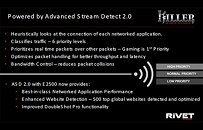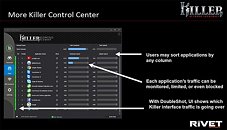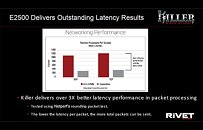Friday, September 16th 2016
Rivet Networks Announces Killer E2500 Ethernet Controller
Rivet Networks Thursday announced its latest gigabit Ethernet controller, the Killer E2500. The E2500 is characterized by advanced QoS features, such as the proprietary ASD 2.0 (advanced stream detect). ASD 2.0 is a feature with which the NIC driver shapes traffic specific to applications. It senses which kind of applications deserve priority over the others. The driver also provides optimization for the top-500 websites on the Internet, by squeezing out the best page-load performance at the web-browser level. The PHY itself offers checksum offload, interrupt moderation, frame-spacing, and large-send offload.
Another major change on the software-side is the new Killer Control center, which gives you manual control over network performance specific to not just games and apps, but also specific websites. The company's asymmetric teaming tech DoubleShot Pro also received an update, giving you control over which app/traffic you want to send through which pipe. The company claims that it has already scored design wins for the chip with motherboard makers ASRock, MSI, Gigabyte; and notebook design wins with Dell-Alienware, Dell-XPS, Lenovo, Clevo, Acer, and Razer.
Source:
HotHardware
Another major change on the software-side is the new Killer Control center, which gives you manual control over network performance specific to not just games and apps, but also specific websites. The company's asymmetric teaming tech DoubleShot Pro also received an update, giving you control over which app/traffic you want to send through which pipe. The company claims that it has already scored design wins for the chip with motherboard makers ASRock, MSI, Gigabyte; and notebook design wins with Dell-Alienware, Dell-XPS, Lenovo, Clevo, Acer, and Razer.




19 Comments on Rivet Networks Announces Killer E2500 Ethernet Controller
The only advantage Killer has is if you're running something that starts a download in the background, it'll put a low priority on that while you're gaming.
Not had any problems with their drivers, although I've admittedly only had this board for a few weeks.
QoS really needs to be router level or it won't matter at all unless you're the only person using the internet connection, which I guess a lot of us aren't so...
I also avoid mobos with Killer NIC.
but so is Intel.
Speaking of speeds, it's possible we'll see 2.5Gb Ethernet (a current IEEE 802 project, along with 5Gb) next year. That's when we'll all be excited about a new controller press release :D
The idea that you could somehow make your packets faster worldwide by something you install in your local machine is right up there with homeopathy level bullshit.
What it can do is take work away from the CPU in high bandwidth scenarios, freeing it up for other tasks. Their usecase is that this would be true for gaming and should improve fps. If your CPU is so weak that it cannot handle a Mb/s stream of data while gaming, your money would be MUCH better spent on a new mobo/cpu combo though.
These things have no reason to exist, but for marketing.
On my next motherboard I was already planning to make sure it did not have a Killer nic for these reasons and my bad experiences with them. The nic is just something you are better off with have a standard 1000 Mbit one from Intel that is solid and works well, and do QoS in your router if you feel it's necessary. Your network speeds are far more reliant on other things like ISP congestion and bandwidth, the servers you are connecting to, etc, than your nic. It's a bit like the companies selling loud overpriced mufflers for a compact car and marketing it that it will magically turn it into a fast race car.
But the problem is that in between there's often a router or modem doing all different sort of things. You still cant bypass with better latency's towards any DC interconnect.
...well, I'm using WLAN via 4G hotspot from my phone even for gaming :rolleyes: